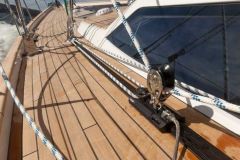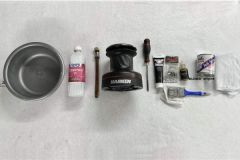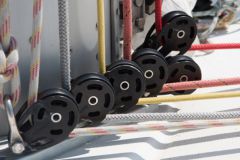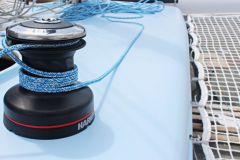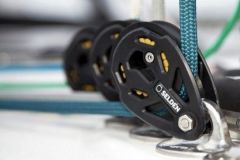Deck covers that end up leaking
There are a number of possible causes of deck panel leaks. The purpose of this article is not to review them all. The method we propose concerns a type of cover that is very common on production boats. They are made of aluminum alloy and methacrylate (plexi). The frame is made of an anodized, bent and welded profile. The sash is more sophisticated. It is made of two identical parts, in the shape of "U", joined together by screwed assembly components.

A profile seal is responsible for sealing between the translucent plate and the aluminum frame, also between the frame and the frame! This is a lot for a single seal, especially since it is a profile, cut to a certain length to make a perfect turn, whose two ends are glued together to ensure the overall consistency of the seal.
Alas, after having undergone the irreparable offense of a few years of service at sea, it may happen that the glueing retires. Then, the two ends momentarily take leave of each other and it's the leak! When it's above a bunk, it's annoying...
Complex manufacturer solutions
This conscientious manufacturer offers a gasket replacement kit. You can even find a video on the internet showing a gentleman performing the operation with a smile on his face, suggesting that it's all just a bit of fun. We tested it for you Although we are not particularly clumsy with our fingers, we were not delighted...
A simple alternative repair method
We have therefore looked for other methods which are not without flaws. But they are accessible to many who are resourceful and above all not very "expensive", which does not spoil anything. To begin with, let's point out that the "accessories" of the hood that are fixed by screws or through pins are significant sources of leaks that must be carefully inspected.
Sealing between frame and sash
Often, the two ends of the joint have separated and leave a "gap" that can reach several millimeters.
- We start by "spreading" the frame with furniture or floor wax. This is so that the elastomer that will soon be used does not adhere to it.
- Then, degrease well the parts to be glued.
- Then fill the space with the elastomer by adjusting the shape with a straight spatula that will be guided by leaning on both sides.
- Then close the cover without tightening the rim screws
- Do not touch it again until the next day
Sealing between the aluminum frame and the plexiglass of the deck panel
- using a new blade cutter (if the operator has a new core, it's good as well), carefully cut the small bead that forms the joint. You must guide the blade by pressing it against the aluminum frame (not against the plexi).

- Remove the defective profile and clean the throat thoroughly with soap and water. Finish by degreasing with methylated spirits. Acetone can be used, but care must be taken not to damage the methacrylate.

- Protect both edges of the groove with masking tape.
- Fill the gap with an elastomer with the following characteristics: excellent adhesion to aluminum and Plexiglas, high percentage of elongation (at least 400%), good UV resistance.

- Remove excess "paste" with a narrow spatula

- Peel off and discard the adhesive protections, taking care not to smudge the surrounding area.
And that's it, the hood is like new! Don't touch anything else until the seal has polymerized. Despite the temptation, wait until the next day to check that everything is fine before giving in to the joy of this great success and come back to the site to share your satisfaction with the world in comments!



